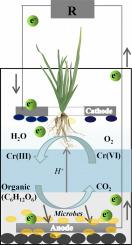Journal of Water Process Engineering ( IF 7 ) Pub Date : 2022-08-04 , DOI: 10.1016/j.jwpe.2022.103040 Shentan Liu , Feifan Lu , Dengfei Qiu , Xiaojuan Feng

|
This study evaluated the effects of electrode arrangement and aquatic plant selection on the performance of single-chamber constructed wetland-microbial fuel cell (CW-MFC) in the treatment of wastewater containing Cr(VI). The CW-MFC with the electrode distance of 10 cm obtained the highest Cr(VI) removal efficiency of 98.8 % at 9 h and the largest power density of 37.8 mW/m2. Short electrode distance would destroy anodic anoxic atmosphere by oxygen secretion of plant roots, while large electrode distance would increase the internal resistance of the system. In the three sets of CW-MFCs with different cathode areas of 25 cm2, 75 cm2 and 100 cm2, the system with 75 cm2 cathode area achieved the highest maximum power density of 39.9 mW/m2 and corresponding Cr(VI) removal efficiency of 90.9 %. Cr(VI) removal by the CW-MFC conformed to first-order kinetics, and the main Cr(VI) removal mechanisms involved cathodic reduction of Cr(VI) to Cr(III), Cr(III) deposition and plant uptake. High-throughput analysis indicates that Lactococcus and Streptococcus were key electroactive bacteria for bioelectricity generation, while Rhodobacter and Hydrogenophaga were responsible for cathodic Cr(VI) reduction. To select optimal wetland plant with the characteristics of both high Cr enrichment capacity and high bioenergy output performance, six CW-MFCs with different plant species were established. Scirpus Validus CW-MFC exhibited better comprehensive performance with maximum power density of 40.6 mW/m2 and Cr(VI) removal rate constant of 0.346 h−1. For ensuring high electricity yield and efficient Cr(VI) removal, Scirpus validus can be selected as the optimal aquatic plant of the CW-MFC.
中文翻译:

人工湿地-微生物燃料电池处理含Cr(VI)废水的湿地植物选择及电极优化
本研究评估了电极排列和水生植物选择对单室人工湿地-微生物燃料电池(CW-MFC)处理含Cr(VI)废水性能的影响。电极距离为10 cm的CW-MFC在9 h时的Cr(VI)去除效率最高,为98.8 %,最大功率密度为37.8 mW/m 2。电极距离短会因植物根系分泌氧气而破坏阳极缺氧气氛,而电极距离大会增加系统的内阻。在阴极面积分别为 25 cm 2、75 cm 2和 100 cm 2的三组 CW-MFC 中,系统以 75 cm 2阴极区域达到了最高的最大功率密度 39.9 mW/m 2和相应的 Cr(VI) 去除效率为 90.9 %。CW-MFC对Cr(VI)的去除符合一级动力学,主要的Cr(VI)去除机制涉及将Cr(VI)阴极还原为Cr(III)、Cr(III)沉积和植物吸收。高通量分析表明,乳球菌和链球菌是生物发电的关键电活性细菌,而红杆菌和嗜氢杆菌负责阴极 Cr(VI) 还原。为了选择兼具高Cr富集能力和高生物能输出性能的最佳湿地植物,建立了6个不同植物种类的CW-MFC。Scirpus Validus CW-MFC表现出更好的综合性能,最大功率密度为40.6 mW/m 2,Cr(VI)去除速率常数为0.346 h -1。为确保高发电量和高效去除 Cr(VI),可以选择Scirpus validus作为 CW-MFC 的最佳水生植物。


























 京公网安备 11010802027423号
京公网安备 11010802027423号